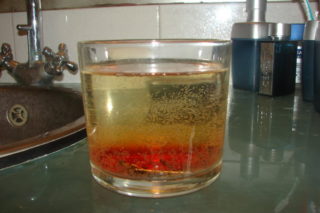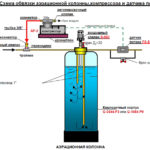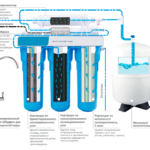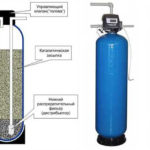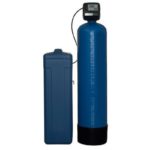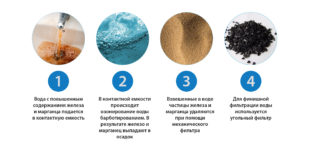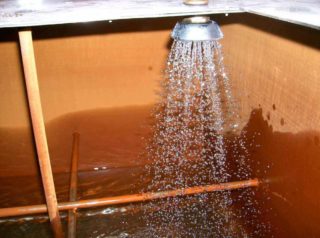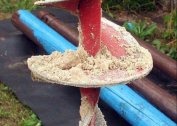Water from a well or a well contains hardness salts, iron, and mechanical suspensions. Not always impurities can be determined visually. Dissolved iron appears after oxidation in air. Plumbing fixtures are covered with a reddish coating, household appliances deteriorate, people's health suffers. The filter for iron removal from the well will eliminate all problems. When choosing a model, consider the chemical composition of the liquid, the performance and functionality of the installation.
How iron gets into water
Above the aquifers are several layers of soil. Moisture, passing through them, dissolves and captures particles of minerals, rocks, ore. In addition to natural impurities, the concentration of iron is increased by wastewater discharges from chemical enterprises, and residues of fertilizers from the fields.
The metal is in liquid in various forms, depending on the valency, the organoleptic perception changes. Iron happens:
- Divalent - soluble in water, does not affect transparency.
- Trivalent - insoluble hydroxide gives a reddish color.
- Colloidal - fine suspensions that cannot be filtered.
- Bacterial - symbiosis with bacteria manifests itself in the form of a film or a jelly-like substance.
- Organic - metal binds to organic molecules, forms chelates. Gives the liquid a yellow-brown color.
The concentration of iron is detected by analysis in the laboratory. Usually there are several types of metal compounds at the same time.
Why water treatment is needed
 Impurities make the liquid unsuitable for drinking. It becomes muddy, smells unpleasant. Its use leads to health problems. Diseases of the kidneys, heart, liver develop, the risk of oncology increases. Impurities adversely affect the skin, causing allergies and dryness. Metal deposits appearing on the parts of household appliances provoke their breakdown. A coating of rust covers the surface of the sink, bathtub, toilet bowl. You have to spend money and effort to cleanse them.
Impurities make the liquid unsuitable for drinking. It becomes muddy, smells unpleasant. Its use leads to health problems. Diseases of the kidneys, heart, liver develop, the risk of oncology increases. Impurities adversely affect the skin, causing allergies and dryness. Metal deposits appearing on the parts of household appliances provoke their breakdown. A coating of rust covers the surface of the sink, bathtub, toilet bowl. You have to spend money and effort to cleanse them.
The normal content is 0.3 mg / L. In some wells, the indicator reaches 1-5 mg / l. In this case, the liquid has a pronounced metallic taste, brownish color. The glandular water filter will remove impurities from the well and make it potable. To clean the liquid, there are several methods that are selected depending on the degree of contamination and financial capabilities.
Types of iron removal filters
Filtration plants use an oxidation reaction to remove impurities. The process occurs under the influence of oxygen, chemicals or catalysts. During oxidation, ferrous iron goes into an insoluble form and precipitates. You should familiarize yourself with the most popular iron removers for private homes and summer cottages.
Aeration
Water treatment by air flow leads to rapid oxidation of the metal and its precipitation in the form of flakes. Systems are divided into two categories: pressure and non-pressure. They act on a similar principle. Air is pumped into the container with water by the compressor. Pure water comes from the lower third of the tank. It is supplied to the water supply by a surface pump. Sludge from the bottom of the tank is discharged into the sewer. Aeration is a safe and effective cleaning method. The installation works without chemicals. The aeration process allows you to save water from hydrogen sulfide.
Ion exchange
Filters filled with ion-exchange resin immediately eliminate two problems - they soften the liquid and remove iron from it. In the course of the reaction, iron, magnesium and calcium ions are replaced by sodium ions. Small installations have a flask with a replaceable cartridge. Automatic systems are produced in the form of columns with filling. Regeneration of synthetic granular filling occurs with a solution of sodium chloride. Plus, ion filters are a rare filler replacement every 5-7 years.
Reverse osmosis
The use of a semi-permeable membrane allows for the most efficient cleaning. It passes only water molecules, cutting off all impurities. Deposits are automatically removed to the sewer. The installation consists of several stages of filtration. It carries out preliminary mechanical cleaning, as well as post-filtering with a carbon sorbent. The reverse osmosis system is equipped with a separate crane and storage tank. This is an expensive option that is installed in a house with permanent residence.
Catalytic
Filters are columns made of fiberglass, inside which there is a special backfill. When passing through granules, iron oxidizes and turns into a precipitate. Particles of metal settle on granules. Contamination from the load is washed out by a stream of fluid discharging into the sewer. Installations are used only for cold water.
- Aeration water treatment
- Reverse osmosis
- Ion exchange filter
- Catalytic filtration
Adding chemicals to water speeds up the oxidation process. The reaction catalyst is: hydrogen peroxide, potassium permanganate, sodium hypochlorite. The precipitated iron is removed. Regents are rarely used in everyday life. Working with them requires accurate dosage and the cost of buying chemicals.
Top manufacturers
Geyser
Geyser installations simultaneously with deferrization soften the liquid. The first stage is the mechanical cleaning of suspensions. At the second stage, in a column filled with cation exchange resin, organic dissolved iron, manganese, and humic acids are removed. Finishing preparation takes place in a flask with a sorbent. The price of such an installation is from 40,000 rubles.
Aquaphor
The Aquaphor WaterBoss 700 system performs filtering according to three parameters: mechanical cleaning of the sludge, deferrization and softening. The column of the device uses a filling of ion-exchange resin, restoring the properties after washing. Productivity of the installation is 1.5 cubic liters per hour. The filter is designed for an iron concentration of up to 10 mg / L. The average cost of the product is 70,000 rubles.
Atoll
A popular manufacturer of reverse osmosis systems offers filters with 4 or 5 stages of purification. Kits vary in performance and storage tank size. A common fact for all models is a high degree of contamination removal. Using a carbon post-filter improves the taste of water. The system is easy to maintain, enough to change cartridges 2 times a year.
- Atoll
- Geyser
- Aquaphor
Installation of a filtration system
When choosing a filtration system, its technical characteristics, cost, dimensions and customer reviews are taken into account. The main criteria:
- performance;
- permissible concentration of impurities;
- volume and type of backfill;
- operating pressure.
The installation of complex multi-stage filter systems is best left to professionals. If you are installing it yourself, you should remember to use a mechanical filter. It retains large particles and extends the life of expensive cartridges. Due to the large size, a pressure aeration system is installed in a separate room. A set of reverse osmosis filters is placed under the sink.During the installation of installations, contaminated water is discharged to the sewer.
DIY iron removal filter
High prices for filters for cleaning water from a well from iron, manganese and other impurities are forcing source owners to look for alternative methods. The simplest of these is liquid settling. After 12-14 hours, the flakes of iron settle to the bottom of the tank, and water can be used for domestic purposes.
A home-made filter for cleaning water from iron from a well is a budget option that requires low costs for the purchase of installation elements. You must purchase a container of plastic with a volume of 200 liters or more. It receives water from the well. To enrich the liquid with oxygen, a compressor is installed or the flow is supplied through watering cans. The storage tank must have a lid, air is accessed through the holes drilled in it.
Inlet from the well and water drainage into the house is carried out by plastic pipes. The entrance is located in the upper part, and the drain is about 50 cm from the bottom. Precipitated sediment is removed through a tap incised at the bottom level. Cleaning occurs 1-2 times a week. Rusty sediment merges, the tank is washed. With severe contamination, several stages of cleaning are established.
Iron removal from a well or a well can be done using any of the methods listed. The costs of buying a filter will pay off by maintaining the health of family members, the excellent condition of household appliances and plumbing.
